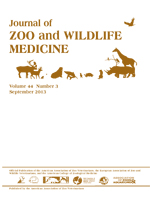A 9-yr-old male meerkat (Suricata suricatta) living in captivity, with a history of anorexia, lethargy, and weight loss, was examined postmortem. Physical examination revealed poor body condition, dehydration, and icteric mucous membranes. Macroscopically, white to yellowish, multinodulated masses were found protruding from the liver. These multinodular masses were also observed in all lobes of the lungs and the mediastinal lymph nodes. Microscopic examination revealed tumors with well-circumscribed, atypical proliferating cuboidal to columnar bile duct epithelial layers arranged in solid sheets and papillary patterns. The neoplastic masses were separated by dense fibrous connective tissues and invaded the normal parenchyma. Periodic acid-Schiff–positive material was occasionally found within the lumen of tubuloacinar structures. Immunohistochemical labeling revealed that neoplastic cells were intensely positive for pan-cytokeratin, but negative for vimentin. Based on the macroscopic and microscopic findings, intrahepatic cholangiocarcinoma was diagnosed. This is the first report describing cholangiocarcinoma in a meerkat.
How to translate text using browser tools
1 September 2013
INTRAHEPATIC CHOLANGIOCARCINOMA IN A CAPTIVE MEERKAT (SURICATA SURICATTA)
Kittikorn Boonsri,
Jiraporn Sritan,
Thewarach Vechmanus,
M. Gerard O'Sullivan,
Kidsadagon Pringproa
ACCESS THE FULL ARTICLE
immunohistochemistry
Intrahepatic cholangiocarcinoma
meerkat
neoplasm
pathology
Suricata suricatta





